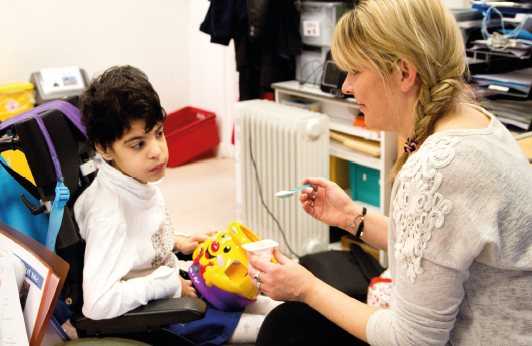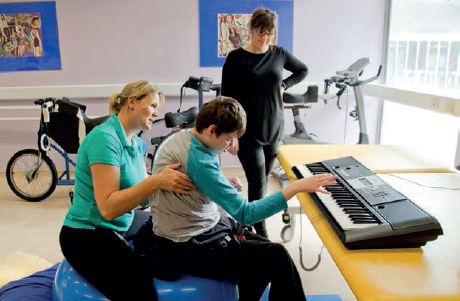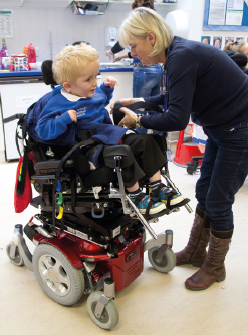- Latest NewsUp-to-date articles giving you information on best practice and policy changes.
- Skills AuditsEvaluate your skills and knowledge, identify gaps and determine training needs.
Working with medical staff at a special school: case study
A special school for children with extremely complex needs outlines how educational, medical and care staff work closely together in the best interests of the child
Go straight to
- Amelia’s profile
- Sharing expertise
- Leadership and shared values
- Parental involvement and staff training
- Next steps
Amelia’s profile
Every child has a personal profile containing separate pages for different aspects of their learning, with aspirations, outcomes, mid-term goals and immediate ‘next steps’.
The individualised curriculum each child follows is child driven, and their therapy needs are integrated within that. It is a working document, and by way of illustration, Ms Green, comments on some of the entries in Amelia’s profile.
‘Amelia’s equipment support (ever-changing as she develops) includes her communication aids (her touch keys and her sensory cues) and her orthotics to keep her safe while she is doing her movement. She also has a lying-out board to keep her calm and safe during floor work, and a stander complete with a tray, where we lay out resources to engage her in learning from an upright position. The stander is wonderful, as it allows her to explore the world from a whole new perspective, and we incorporate it regularly into her programme.
‘Meanwhile, the speech and language therapy team has created a programme of little tasters that can be put on her lips. Now I know that when we are exploring Africa later in the term, it will be safe to let her do a little bit of tasting of vanilla and cinnamon.
Creativity is enhanced when people from different disciplines work together
‘With regard to her physical development engagement, although she is registered blind, it has become clear that she is definitely aware of light sources, so we are working on that. Even when she is in the dark room, she is busy working on a programme the occupational therapists and the speech and language therapists have developed around light work and tracking.
‘Her communication profile has been created by NHS and school staff together as an integrated approach to learning, covering both expression and how she understands us receptively. Plus what we can do to support her, whether it’s low tech or high tech – from objects of reference to Eye-gaze machines and making auditory choices through scanning and iPad.
‘She also has a physiotherapy chest programme which she does every morning. If secretions can be cleared, she is more comfortable to learn, and it means she spends less time in the hospital. The therapists provide us with picture diagrams of some of the activities so that a consistent approach is used to maximise the benefits for her.
‘There are some additional therapy programmes too. So her curriculum is made up by a multitude of practitioners all pursuing her potential and keeping her best interests at heart.’
‘Amelia has been doing some very important floor work, one of the prerequisites of early learning and child development, so that she can build up the strength to sit up straight,’ Meriel Green tells me as she shows me round her classroom at Chailey Heritage School in East Sussex.
‘At the same time, she has been engaging in numeracy, so educational goals and physiotherapy are intertwined. We have learned the skills to support her on the floor from the regular sessions we have with physiotherapists during the week. Then throughout the day, we can continuously use these to develop her potential in learning.’
Sharing expertise
Continuing my tour, she takes me to another part of the room. ‘This young boy has got some very high medical needs present today,’ she says, ‘so we are going to do some floor work, but build in the use of mirrors for self-exploration. So while he may be resting, he is still learning. Otherwise, he would be in the hospital today. But we are able to facilitate his needs because the doctor is on call and will come to see him immediately if necessary.
Staff are constantly modelling professional standards for each other
‘We also know what angle to keep him at because the speech and language therapist has done an assessment on his swallow. And we know that part of his Education Health and Care Plan is to understand himself better, so we will incorporate that using the mirror and exploration of himself through imagery.
‘Meanwhile this young lady over here has just been doing some texture exploration on the floor,’ she adds, as one of her pupils prepares to leave the room. ‘She is now going out into the hall where she will use the hoist to stand up and get that feeling of gravity, which then benefits her digestive system and attention awareness. We know which sling to put her in because the occupational therapist came over and did an assessment with us.’

Sophie keeps the colourful toy she has been using for numeracy work on her lap as she eats her yoghurt. When she has had enough, she signs that she has finished, and at the same time relinquishes the toy. Importantly, both decisions are hers.
NHS and education come together
What these and all the other children in the class are doing encapsulates the principles that underpin everything that happens in this specialist school for children aged 3-19 with complex physical disabilities, high health needs, sensory impairments and associated learning difficulties.
However, it wasn’t always so, as headteacher Simon Yates explains, pointing to an Ofsted quote he has pinned up on his study wall: ‘For outstanding practice, other professionals have a central role in the school’s curriculum development.’
‘When I saw it, it was just so obvious to me that where that was happening here, that was where best practice was taking place,’ he says. ‘The trouble was, it was only in pockets. Now, thanks to our partnership with the NHS, it is embedded in the school.’
This strengthening of ties came about around five years ago when a reshuffle in Chailey Heritage Clinical Services, part of Sussex Community NHS Trust and based on site, led to the appointment of physiotherapist Jane Windsor as head of clinical support to pupils, effectively his opposite number in Clinical Services.
‘It needed two people at the top who connected,’ he says. ‘We still belong to entirely separate entities – I can’t manage her staff nor she mine – but rather than just working alongside each other, there is much more joint preparation, looking at the whole child. The ethos is about teamwork – not just amongst education and medical staff, but amongst everyone, from care and residential staff to people in administrative roles.’

Liam is working with physiotherapist Nicky Montoya while his TA observes. Yesterday Ms Montoya had him sitting on a box, today he has progressed to a wobbly cushion. The aim is to engage him in stretching exercises. As he loves making music, reaching out to touch the keyboard is his incentive to challenge himself.
Leadership and shared values
For Ms Windsor, it is also about leadership. ‘Because school staff and therapists work together in the classroom and in the gyms, they are constantly modelling professional standards for each other,’ she says. ‘In a sense, everybody is a bit of a leader; everybody has a responsibility to provide quality service.’
Communication is key to these young people
She goes on to highlight the importance of shared values – pursuing children’s potential, showing care and compassion and never giving up, no matter what. Parents are heavily involved as well and play a key part in the big multi-disciplinary circle.
‘The other thing we have invested heavily in is communication,’ she continues, ‘both between staff of all kinds working at all times of the day and between Mr Yates and myself. And, obviously, communication is key to these young people. They need to be able to make their choices in the world known, and to me, that is hugely important.’
The holistic approach
To illustrate how the holistic approach works, Ms Windsor takes the example of motor groups, such as standing box groups or balance work. These sessions are usually led by a physiotherapist or physiotherapy assistant, but sometimes the teacher or an experienced TA will take on this role. ‘That means we have a flexible approach,’ she says. ‘If there is an emergency somewhere else, or we haven’t got the usual staff, other people can take over.’
The same is true the other way round and it is not unusual to see a therapist leading a session in class. Moreover, because they know what the children are learning, their input into lesson planning is invaluable.
‘Creativity is much enhanced when you have people from different disciplines working together, thinking around a problem or devising an intervention,’ says Mr Yates. ‘All their different skills and areas of knowledge come together, and they know the child in different ways as well sometimes.’
What emerges from these discussions is then carried over into every area of the child’s life. Whether it’s a yes/no response, a physical target or choosing between two things, it is built into occupational therapy work, swimming sessions, music sessions, hygiene sessions and more, and continues when the child retires to the bungalow in the evening.
‘So first there is the creativity involved in working out what we can and should be doing,’ concludes Mr Yates. ‘Then there is the consistency and continuity of everybody knowing for each child what we should be carrying out, what we should be looking for, and when we should be saying: “Wow! Can we build on that? Can we make this into a new avenue of approach?”’
Parental involvement and staff training
As in any special school, parents are invited to formal reviews at set times of the year, but there is also ongoing day-to-day communication through home-school diaries, emails and phone calls, particularly with the parents of younger pupils.
‘While we are still learning everything we possibly can about the child, we have a huge amount of input from the parents,’ Mr Yates remarks. ‘As time goes by, they tend to step back a little and communication becomes more sporadic. But they are involved all the way through with all the profiles we write, looking with us at the outcomes and sharing what they think the next step should be.’
‘We have some very good ideas from parents,’ he adds. ‘Although we are specialists, they know their child better than anyone. Sometimes we pick up something they are doing that we think might work well with someone else. So they are a very valuable part of the community.’
Meanwhile, a robust training programme ensures that all members of staff are highly skilled. This includes a day and a half of induction training four times a year for new staff, NHS and education alike, followed by extensive theory training around gastrostomies, seizures, medication and more.
Transferability
It’s very unusual to have a team of diverse specialists to hand on your doorstep, so what might other schools take from Chailey’s experience?
‘Obviously, it is not a model that can be replicated everywhere, but I think the principles of the integrated approaches can be,’ replies Mr Yates. ‘Instead of teachers and therapists having different sets of plans and targets, if they can find time to sit down and create something together, when the therapist has gone, school staff will be able to carry on with the work they have been doing because they understand what’s involved. Going back to that Ofsted quote, if therapists work out with the teaching team what the best approaches might be, then the teacher can take that on and build it into PE, maths or whatever.’
Ms Windsor agrees, adding that modelling is also really important. ‘This morning I had a session and we all did the therapy together. Mum was there, it was very hands on, everybody was chatting and the young boy was involved as well. If teachers or TAs could take part in a session like that, they would know what to do and be able to think of opportunities when they could support the young person to keep developing their skills.’
Mr Yates’ other piece of advice is to find ways of making therapy targets meaningful. ‘Having somebody walk up some steps and then back down again isn’t nearly as motivating as sending them up to get to something,’ he says. ‘We have children who are doing all sorts of stretches. Yesterday, I saw Henry absolutely loving it, trying to reach a box as part of a game in class. I knew that was part of his physiotherapy that had been built into the session by the teacher. It’s about weaving it all together.’
Next steps
 Henry started the morning lying back on soft cushions on the floor as he worked with speech and language therapist Claire Hall on making choices; more specifically, on learning how to choose something using a colour photo rather than an object of reference, the ‘next step’ in his communication profile.
Henry started the morning lying back on soft cushions on the floor as he worked with speech and language therapist Claire Hall on making choices; more specifically, on learning how to choose something using a colour photo rather than an object of reference, the ‘next step’ in his communication profile.
When she left his side to prepare his mid-morning snack, there was evidence of progress towards another ‘next step’. In the past, he would become distracted and restless at this point. Today he waited calmly and patiently, demonstrating that his understanding of routine is becoming more extended.
Now Ms Hall is settling him into his chair, making sure he is well positioned and comfortable. She sings Old McDonald Had a Farm as she works, and Henry interacts with her throughout, engaging with the song and joining in with the rhythm.
This article is taken from Special Children Magazine, issue 228. PDF versions of the magazines are available to download in the My Account area under My Magazines for Optimus Education subscribers.
Last Updated:
25 Apr 2019


